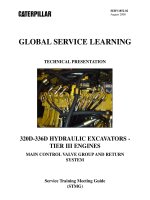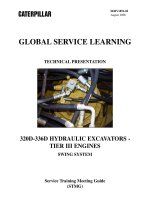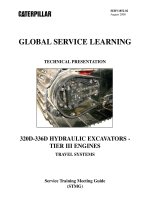- Trang chủ >>
- Khoa Học Tự Nhiên >>
- Vật lý
104 PRB59 8784 camno3 d
Bạn đang xem bản rút gọn của tài liệu. Xem và tải ngay bản đầy đủ của tài liệu tại đây (113.98 KB, 5 trang )
PHYSICAL REVIEW B
VOLUME 59, NUMBER 13
1 APRIL 1999-I
Large magnetoresistance in antiferromagnetic CaMnO3؊␦
Z. Zeng and M. Greenblatt*
Department of Chemistry, Rutgers, The State University of New Jersey, Piscataway, New Jersey 08854-8087
M. Croft
Department of Physics, Rutgers, The State University of New Jersey, Piscataway, New Jersey 08854-8019
͑Received 22 October 1998͒
CaMnO3Ϫ␦ with ␦ ϭ0, 0.06, and 0.11 was prepared by the Pechini citrate gel process at 1100 °C. Oxygen
defects were created by quenching the sample from high temperature. Chemical analysis and x-ray absorption
show that the formal valence of Mn in CaMnO3 is close to 4ϩ, and that Mn͑III͒ is created in the quenched
samples. Moreover the x-ray absorption near-edge spectra results support the creation of two Mn͑III͒ five
coordinate sites for each O vacancy. CaMnO3Ϫ␦ ( ␦ ϭ0 – 0.11) are n-type semiconductors and order antiferromagnatically with Ne´el temperatures close to 125 K. The activation energy decreases with increasing ␦. A
relatively large ͑ϳ40%͒ negative magnetoresistance ͑MR͒ is observed for CaMnO2.89. This result shows that a
substantial MR can occur in these G-type antiferromagnetic materials. ͓S0163-1829͑99͒02913-6͔
INTRODUCTION
of A- and G-type manganites, we may shed some light on the
mechanism of GMR and CMR materials.
Recently, magnetoresistance materials have attracted
much attention both because of their interesting fundamental
structural, electronic, and magnetic properties and their potential application for magnetic recording and sensing.1–5 By
far the La1Ϫx Mx MnO3 (M ϭBa, Sr, Ca, Pb͒ system has been
studied in the greatest detail.6–9 Three types of the magnetic
structures have been established in this system: LaMnO3 orders antiferromagnetically ͑AF͒ with an ‘‘A-type’’ perovskite
structure, where the Mn͑III͒ ions order ferromagnetically
͑FM͒ in planes and AF between planes; La1Ϫx Cax MnO3
(0.1ϽxϽ0.5) orders FM with a ‘‘B-type’’ structure, while in
CaMnO3 neighboring Mn͑IV͒ ions order AF with a ‘‘Gtype’’ structure.10 LaMnO3 has been studied in great
detail.11,12 The formal valence of Mn is near 3ϩ for the
stoichiometric compound. However, part of the Mn͑III͒ can
be oxidized to Mn͑IV͒ under suitable conditions due to either
or both Ln and/or Mn cation deficiency. This leads to
Mn͑III͒-O-Mn͑IV͒ double exchange interactions and
La1Ϫx Mn1Ϫy O3 shows a semiconductor-to-metal transition
͑SM͒ at ϳ200 K with colossal magnetoresistance ͑CMR͒
near the SM transition temperature.13,14 In CaMnO3Ϫ␦ , the
other end of La1Ϫx Cax MnO3 system, the formal valence of
Mn is near 4ϩ( ␦ ϳ0). Mn͑III͒ should be created in this
compound when oxygen defects are introduced ͑i.e., ␦
Ͼ0). The introduction of Mn͑III͒-O-Mn͑IV͒ moiety would
be expected to decrease the resistivity of the compound, and
may lead to double exchange ͑DE͒ interactions. In contrast
with the hole doped cation-defect La1Ϫx Mnx O3, oxygendefect CaMnO3Ϫ␦ is electron doped with a ‘‘G-type’’ magnetic structure. Several groups15,16 have investigated the
electrical resistance and the magnetic properties of
CaMnO3Ϫ␦ , however, magnetoresistance ͑MR͒ of
CaMnO3Ϫ␦ has not been demonstrated thus far. In this paper,
we report the x-ray absorption near-edge spectra ͑XAS͒,
electrical, magnetic, and magnetoresistance properties of
CaMnO3Ϫ␦ with ␦ ϭ0, 0.06, 0.11. Comparing the properties
0163-1829/99/59͑13͒/8784͑5͒/$15.00
PRB 59
EXPERIMENTAL
CaMnO3Ϫ␦ was prepared by a sol-gel method. Mn͑NO3͒2
was purchased as a 49.7% w/w aqueous solution ͑Aldrich͒.
Appropriate stoichiometries of Mn͑NO3͒2 and CaCO3 ͑Aldrich, 99ϩ%͒ were dissolved in an excess amount of 35%
nitric acid. An excess of citric acid and ethylene glycol were
also added to the solution. The solution was slowly evaporated to a resin and dried. The sample was then heated slowly
to 600 °C to decompose the organic compounds, and pressed
into pellets at 1 Kbar. The ␦ ϭ0 material was sintered in
flowing oxygen at 1100 °C for 24 h, and then slowly cooled
to room temperature. The oxygen-deficient samples were
heated in air to 1100 °C for 24 h and then quenched from
1100 or 1000 °C to room temperature.
The powder x-ray diffraction ͑PXD͒ data were collected
with a SCINTAG PAD V diffractometer with monochromatized CuK ␣ radiation. Silicon powder was used as an internal
standard. Lattice parameters were refined by a least-square
method. The dc electrical resistivity and the magnetoresistance measurements were carried out by a standard fourprobe technique from 400 to 4 K in a superconducting quantum interference device ͑SQUID͒ magnetometer ͑MPMS,
Quantum Design͒. Magnetic properties were also measured
with this SQUID magnetometer in the temperature range
4–400 K.
The Mn K-edge XAS measurements were performed on
beam lines X-19A and X-18B at the Brookhaven National
Synchrotron Light Source using a double crystal Si ͑311͒ and
channel cut Si ͑111͒ monochromator, respectively. Electron
yield, fluorescence mode, and transmission mode measurements were made and checked for consistency. A standard
was run simultaneously with all the measurements for precise calibration. The relative energies between various spectra were established by careful comparison of the standard
spectra. In general the relative accuracy of the energy is
8784
©1999 The American Physical Society
PRB 59
LARGE MAGNETORESISTANCE IN . . .
8785
TABLE I. Oxidation state and lattice parameters for CaMnO3Ϫ␦ .
Composition
T q ͑°C͒a
Mn valence
a ͑Å͒
b ͑Å͒
c ͑Å͒
V ͑Å3͒
CaMnO3
CaMnO2.94
CaMnO2.89
No quench
1000
1100
3.99
3.88
3.78
5.2641͑3͒
5.2647͑3͒
5.2644͑1͒
5.2782͑2͒
5.2792͑2͒
5.2802͑1͒
7.4546͑1͒
7.4601͑1͒
7.4622͑2͒
207.13͑2͒
207.34͑2͒
207.42͑1͒
a
T q temperature of quenching.
about Ϯ0.05 eV.17 All spectra were normalized to unity step
in the absorption coefficient from well below to well above
the edge.
Chemical analysis were made with a Baird Atomic Model
2070 inductively coupled plasma emission spectrometer
͑ICP͒. The oxidation state of Mn was determined by a
chemical titration in which the samples were dissolved in
dilute sulfuric and phosphoric acids with an excess of
Fe͑NH4͒2͑SO4͒2, and titrated with KMnO4 solution.
RESULTS AND DISCUSSIONS
Oxidation State of Mn. Chemical titration shows that the
formal oxidation state of Mn is near 4ϩ for the sample prepared in oxygen atmosphere ͑Table I͒. The formal oxidation
state of Mn decreases with increasing temperature of quenching. The results of the titration measurements can be interpreted in terms of the titration-Mn-valence v t (Mn) and/or
the O-vacancy content ␦ ͑i.e., CaMnO3Ϫ␦) with v t (Mn)ϭ4
Ϫ2 ␦ . For the O2 prepared and 1100 °C quenched materials
values of ␦ ϭ0/v t (Mn)ϭ3.99 and ␦ ϭ0.11/v t (Mn)ϭ3.78
were found. Thus the titration results indicate that about 20%
of the Mn sites are reduced to Mn͑III͒ in the CaMnO3Ϫ␦ ( ␦
ϭ0.11) material. The results of the Mn-K XAS, below, support the formation of two Mn͑III͒ sites associated with each
of these O defects.
The Mn-K edges of the CaMnO3Ϫ␦ with ␦ ϭ0 and ␦
ϭ0.11 along with that of the Mn͑III͒ compound LaMnO3,
are shown in Fig. 1. The most intense B feature at these
edges is related to 1s-to-4p transitions. The systematic upshift of this feature with increasing Mn valence has been well
established in studies of the La1Ϫx Cax MnO3 system ͑illustrated in Fig. 2 by the end point spectra͒.17 Comparing the
CaMnO3Ϫ␦ ( ␦ ϭ0.11) spectrum with that of CaMnO3 one
notes that, although their B features peak at the same energy,
there is substantial excess intensity in the O-deficient spectrum on the low-energy side of the B peak. Indeed the placement of the excess intensity is suggestive of a new component in the spectrum with a B feature close to that of
LaMnO3.
The presence of an O vacancy, at the shared corners of
adjacent Mn octahedra, would be expected to induce two
adjacent Mn͑III͒ sites into the Mn͑IV͒ lattice of CaMnO3.
With this in mind, one can extract an estimate of the Mndefect site spectral component by assuming that the ϳ80%
Mn͑IV͒ component of the spectrum is unchanged from that
of the fully oxidized CaMnO3. ͓Note the 22% Mn͑III͒ concentration has been rounded to 20% since the method is only
approximate.͔ The approximation of the defect-site ͑DS͒
spectrum, by a weighted, renormalized difference spectrum,
is shown in Fig. 1. One should note that the peak of the
DS-difference spectrum is at the same energy as that of the
Mn͑III͒-LaMnO3 spectrum. The additional structure on the
low-energy side of the difference spectrum ͑in the energy
range labeled A͒ is not unreasonable in view of the distorted
five-coordinate defect environment. Such a distorted environment typically leads to splittings in the 4 p features at the
K edges of transition metals.18,19 This identification of a distinct Mn͑III͒ site spectral component in the Mn͑IV͒ background stands in contrast to the La1Ϫx Cax MnO3 system
where a continuous shift of the Mn-K edge spectra from
Mn͑IV͒ to Mn͑III͒ was observed.17
Before discussing the expanded-energy-scale pre-edge a
feature, it is worth noting the behavior of the D * feature,
shown in Fig. 1. In the previous XAS study of the
La1Ϫx Cax MnO3 system this D * feature is systematically enhanced with increasing Mn valence. However, discussion of
this D * feature was omitted in the previous work.17 In Fig. 1
the D * feature can be seen to be degraded with O deficiency,
and this is again consistent with the reduction of the Mn͑IV͒
content.
Figure 2 shows an expanded view of the pre-edge spectra,
i.e., the region labeled ͑a͒ in Fig. 1. Comparison of the
CaMnO3Ϫ␦ , ␦ ϭ0 and ␦ ϭ0.11 spectra clearly shows that a
substantial decrease of the a-feature resolution and spectral
weight accompanies the increased O deficiency. ͑The larger
absolute magnitude of the spectral intensity in the a-feature
region of the ␦ ϭ0.11 curve is due to the much larger back-
FIG. 1. Mn-K edge for the Mn͑III͒ perovskite LaMnO3, the
fully oxygenated Mn͑IV͒ perovskite CaMnO3 ͑referred to as I͒, and
the oxygen deficient CaMnO3Ϫ␦ ( ␦ ϭ0.11) ͑referred to as II͒. Motivated by the titration results, which estimate that about 20% of the
Mn sites may be reduced to Mn͑III͒ in the CaMnO3Ϫ␦ ( ␦ ϭ0.11)
material, the defect site ͑DS͒ difference spectrum ͓ (II-0.8I)/0.2 ͔
was plotted. Also the disparity between ␦ ϭ0.11 ͑ϳ22% reduction͒
and the 20% reduction is neglected due to the approximate nature of
the difference spectrum calculation.
8786
Z. ZENG, M. GREENBLATT, AND M. CROFT
PRB 59
FIG. 3. log10 vs 1/T for CaMnO3Ϫ␦ .
FIG. 2. Mn-K pre edge for the Mn͑III͒ perovskite LaMnO3, the
fully oxygenated Mn͑IV͒ perovskite CaMnO3 ͑I͒, and the oxygen
deficient CaMnO3Ϫ␦ ( ␦ ϭ0.11) ͑II͒. The DS difference spectrum
͓ (II-0.8I)/0.2 ͔ estimate is as discussed above. The three components a 1 , a 2 , and a 3 of the CaMnO3 pre-edge should be noted.
ground.͒ In view of the established increased a-feature intensity with increasing Mn valence,17 these observations are
again consistent with the reduction of Mn͑IV͒ to Mn͑III͒
upon O depletion.
Inspection of Fig. 2 also reveals a distinct change in the
a-feature energy distribution in these materials. The
Mn͑IV͒-CaMnO3Ϫ␦ , ␦ ϭ0 a feature can be seen to contain
three identifiable subfeatures a 1 , a 2 , and a 3 . ͑Previous,
lower resolution work only identified the a 1 and a 2
features.17͒ The Mn͑III͒-LaMnO3 a feature consists of a
broad, much weaker, and apparently unresolved bimodal
structure. The LaMnO3, a-feature onset also has a modest
but distinct shift to lower energy relative to the CaMnO3
a-feature onset. The DS-difference spectrum, in Fig. 2, manifests this same distinct shift to lower energy, characteristic of
the Mn͑III͒ character of the defect induced sites. Interestingly the DS also shows a quite robust peak ͑labeled a L ).
The enhancement of this a L -feature intensity ͑relative to that
of LaMnO3) is consistent with the square-pyramidal environment at the defect sites.20 Namely, the enhancement of the
p/d admixture in such noncentrosymmetric sites has been
established to consistently enhance such transition metal preedge features.21
Thus both the main- and pre-edge XAS results provide
evidence of Mn͑III͒ behavior for the defect sites in the
CaMnO3Ϫ␦, system. As noted, this stands in contrast to the
behavior of the La1Ϫx Cax MnO3Ϫ␦ , Mn-K XAS results
where distinct site behavior was not discernible.17 Interestingly, structural studies have shown that the highly
O-deficient CaMnO3Ϫ␦ , ␦ ϭ0.5 material forms a structure
where all sites are equivalent with this five coordination.20
Studies of the crossover to this ordered structure should be
quite interesting and are being pursued. It is worth noting
that the O-defect structure in this system stands in contrast to
that in the SrCoO3Ϫ␦ system where the ␦ ϭ0.5 material
forms the Brownmillerite structure. Indeed Co-K XAS studies show the segregation of four-coordinated Co͑II͒-O defect
and six-coordinated Co͑IV͒-O sites in this Co case.22
Lattice parameters. CaMnO3Ϫ␦ crystallizes in orthorhombic perovskite structure in space group P nma . 20 The unit cell
parameter c and the volume increase with increasing quenching temperature, and hence ␦ ͑see Table I͒. This is consistent
with the increase of Mn͑III͒ content and the increased effective ionic radius of Mn͑III͒ ͑0.72 Å͒ relative to that of
Mn͑IV͒ ͑0.67 Å͒.23
Electronic properties. Figure 3 shows the variation of
log10 with 1/T for CaMnO3Ϫ␦ . All the compounds are
semiconducting. Qualitative Seebeck measurements for these
samples show n-type behavior. The electrical conductivity
increases and the activation energy decreases with decreasing oxygen content over the range of temperatures measured
͑Table II͒. In the oxygen deficient samples the presence of
Mn͑III͒-O-Mn͑IV͒ sites reduces the activation energy substantially. However, the XAS results indicate that the
Mn͑III͒ sites are located near oxygen vacancies. Worledge
et al.24 have found an adiabatic small polaron hopping conductivity of the form ϭ(A/T)e ϪEa/kT ͑or ϭT/Ae Ea/kT ) to
adequately describe the resistivity of the La1Ϫx Cax MnO3
system for xϭ0 – 1.0 in the range 300–1000 K. The results
presented here for the ␦ ϭ0 sample follow the same form at
the temperatures studied, however, the ␦ 0 materials deviate strongly at lower temperatures. There is a change in the
slope of the log10 versus 1/T plot in the 60–80 K range for
the ␦ ϭ0.11 sample ͑Fig. 3͒. This anomaly in the resistivity
could be related to the turnover in the magnetic susceptibility
seen near the same temperature ͑Fig. 4͒.
Magnetic properties. Figure 4 shows the magnetization
͑M͒ as a function of temperature of the samples studied.
Between 150 K and room temperature, M follow the CurieWeiss law ϭC/(TϪ p ) ͑where a linear ϭM /H has been
assumed͒. The Weiss constants p are large and negative for
all of these phases, indicating AF interactions ͑Table III͒. As
noted previously,25 the magnitude of the p parameter, even
TABLE II. Electrical properties of CaMnO3Ϫ␦ .
Composition
E a (10Ϫ2 eV)
E a (10Ϫ2 eV)
CaMnO3
CaMnO2.94
CaMnO2.89
7.07 ͑above 80 K͒
3.38 ͑above 65 K͒
2.20 ͑above 60 K͒
2.46 ͑below 65 K͒
1.33 ͑below 60 K͒
LARGE MAGNETORESISTANCE IN . . .
PRB 59
8787
FIG. 4. Magnetization as a function of temperature for
CaMnO3Ϫ␦ .
FIG. 5. Zero field and field cooled magnetization as a function
of temperature for CaMnO3Ϫ␦ .
in the ␦ ϭ0 material, is too high to be explained by G-type
AF interactions. In CaMnO3Ϫ␦ the O-Mn-O angle is 158°
͑not 180° as in the ideal perovskite structure͒. This distortion
leads to AF order at 125 K, which exhibits spontaneous or
low field spin canting and hence a weak FM component. The
Curie constants ͑C͒ are larger than the expected values and
increase with decreasing oxygen content ͑Table III͒. This is
attributed to the occurrence of Mn͑III͒-Mn͑IV͒ clusters with
a ferromagnetic intracluster interaction.15 Again, however,
the continued large p values do not evidence a longer range
FM component.
The local maxima in the M (T) curves of the O-deficient
materials motivate consideration of magnetic frustration effects such as seen in spin-glass or mictomagnetic systems. In
Fig. 5 the field-cooled ͑FC͒ and zero-field-cooled ͑ZFC͒
magnetization behavior of the ␦ ϭ0 and 0.11 materials both
show disparities. Specifically the ZFC for the fully oxygenated CaMnO3 first increases then tracks the FC curve decreasing, as the temperature is raised. A similar, but larger
effect is seen in the O-defect materials ͑Fig. 5͒. Such behavior is seen in spin glass and mictomagnetic ͑concentrated
spin-glass type materials͒ systems where it is attributed to
magnetic frustration introduced by random competing magnetic interactions. Although it is reasonable that such effects
may be present in the O-deficient materials, their rather robust persistence in the fully oxygenated material makes such
an explanation more difficult. An alternate interpretation,
based on irreversible AF domain spin canting effects, is preferred at present.
The fact that the ͑FC͒ magnetization of this G-type AF
material manifests a FM type increase below T N indicates
field-induced spin canting in the AF phase aided by the spontaneous canting moment. The absence of an AF peak in the
susceptibility at T N indicates that the anisotropy energy,
holding the spins along the preferred direction, must have a
low barrier for spin canting away from this direction. At T
ϭ0 K a ZFC ceramic CaMnO3 sample will have many domains with random orientations of the AF easy axes. When
the field is increased, those domains for which the AF polarization is perpendicular to the field, for which the canting
perpendicular susceptibility is large, will dominate the magnetic response. As the temperature is increased, the AF order
parameter decreases, and some domains will reorient to an
axis perpendicular to the applied field, thereby yielding an
increasing magnetization with increasing temperature. Eventually ͑with increasing T͒, most of the domains will be reoriented and the decreasing AF order parameter will yield
smaller static spins to be canted, thereby leading to a decreasing magnetization with increasing temperature. This is
consistent with the broad maximum observed in the ZFC
magnetization vs temperature ␦ ϭ0 curve in Fig. 5.
In the FC case the AF domains develop below T N with
their AF polarization axes as close as possible to the transverse polarization and with their canted moment parallel
with H. Thus the domains grow with the energetically favorable orientation of the high spin canting perpendicular susceptibility. The increasing temperature FC magnetization
( ␦ ϭ0) therefore manifests only the weakening transverse
response that accompanies the AF order parameter decrease
͑i.e., no maximum occurs as the domains were grown transverse͒.
In the O-deficient material the ZFC magnetization is still
more strongly suppressed at Tϭ0. Moreover in the ␦ ϭ0.11
material even the FC magnetization exhibits a local maximum ͑as do the Hϭ15 kOe curves in Fig. 4͒. This would be
consistent with the Mn͑III͒-O-Mn͑IV͒ clusters having their
net spin aligned with the overall AF polarization axis. In an
external field, the preferred alignment of these clusters would
be along the external field direction. Thus the clusters would
hinder the field-induced transverse reorientation of the AF
domains thereby increasing the low-T down turn in magnetization, due to incomplete transverse polarization. The suppression of the small spontaneous canting ͑at Hϭ0) in the
O-deficient materials probably also occurs. Moreover, the
breaks in the slope of the FC magnetization of the ␦ ϭ0.11
TABLE III. Magnetic properties of CaMnO3Ϫ␦ .
Composition
T N ͑K͒
C ͑emu/mol K͒
eff
p ͑K͒
CaMnO3
CaMnO2.94
CaMnO2.89
125
125
125
2.25
2.46
2.99
4.24
4.44
4.89
Ϫ472
Ϫ494
Ϫ462
8788
Z. ZENG, M. GREENBLATT, AND M. CROFT
PRB 59
materials the field flips selected spin layers. In these
CaMnO3Ϫ␦ materials AF domain reorientation appears to be
important below T N . The O vacancies appear to substantially modify these domain effects. The MR could therefore
be related to AF domain scattering effects ͑somewhat reminiscent of GMR materials͒. Further work is clearly required
to establish the exact mechanism of MR in CaMnO3Ϫ␦ .
CONCLUSIONS
FIG. 6. MR as a function of temperature for CaMnO3Ϫ␦ .
material may indicate actual reorientation phase transitions.
Magnetoresistance. The magnetoresistance is defined as
MRϭ( H Ϫ )/ 0 , where H and are the resistivities at H
and zero applied magnetic field. Figure 6 shows the MR as a
function of temperature for the CaMnO3Ϫ␦ materials. A
negative MR effect is observed below the T N . However, MR
of CaMnO3 is negligible. The concentration of Mn͑III͒ increases with decreasing oxygen content and with it the possibility of local double exchange. The MR is, however, not
related to that seen at the paramagnetic-ferromagnetic–
semiconductor-metal transition in double exchange materials, where the MR is sharply peaked around T c . The MR
here is more analogous to GMR materials where the MR
grows with the AF order parameter below T N . 26 In the GMR
*Electronic address:
1
K. Chahara, T. Ohno, M. Kasai, and Y. Kozono, Appl. Phys. Lett.
63, 1990 ͑1993͒.
2
R. von Helmolt, J. Wocker, B. Holzapfel, M. Schultz, and K.
Samwer, Phys. Rev. Lett. 71, 2331 ͑1993͒.
3
S. Jin, T. H. Tiefel, M. McCormack, R. A. Fastnacht, R. Ramesh,
and L. H. Chen, Science 264, 413 ͑1994͒.
4
H. L. Ju, C. Kwon, R. L. Greene, and T. Venkatesan, Appl. Phys.
Lett. 65, 2108 ͑1994͒.
5
M. McCormack, S. Jin, T. H. Tiefel, R. M. Fleming, and J. M.
Phillips, Appl. Phys. Lett. 64, 3045 ͑1994͒.
6
S. Sundar Manoharan et al., J. Appl. Phys. 76, 3923 ͑1994͒.
7
R. Mahendiran, R. Mahesh, A. K. Raychaudhuri, and C. N. Rao,
J. Phys. D 28, 1743 ͑1995͒.
8
T. Shimura, T. Hayashi, Y. Inaguma, and M. Itoh, J. Solid State
Chem. 124, 250 ͑1996͒.
9
P. M. Levy, Science 256, 972 ͑1992͒.
10
E. O. Wollan and W. C. Koehler, Phys. Rev. 100, 545 ͑1955͒.
11
J. To¨pfer and J. B. Goodenough, J. Solid State Chem. 130, 117
͑1997͒.
12
J. A. Alonso, M. J. Martinez-lope, M. T. Casais, and A. Munoz,
Solid State Commun. 102, 7 ͑1997͒.
13
A. Maignan, C. Michel, M. Hervieu, and B. Raveau, Solid State
Commun. 101, 277 ͑1997͒.
14
W. H. McCarrol, K. V. Ramanujachary, and M. Greenblatt, Solid
State Chem. 136, 322 ͑1998͒.
Titration and Mn-K XAS indicate the reduction of
Mn͑IV͒ to Mn͑III͒ with increasing ␦ in the CaMnO3Ϫ␦ system by the creation of two five coordinate Mn͑III͒ sites per O
vacancy. The resistivity of the electron doped CaMnO3Ϫ␦
decreases as ␦ increases but remains semiconducting in the
range 20–300 K. The superexchange interactions that lead to
G-type antiferromagnetic ordering in the ␦ ϭ0, Mn͑IV͒ material still dominate in the O-defect materials, however, the
AF-domain canting appears hindered. Evidence of FM intracluster Mn͑IV͒-O-Mn͑IV͒ interactions are found in the Curie
constant enhancement with increasing ␦. A large ϳ40% MR
is demonstrated in CaMnO2.89.
ACKNOWLEDGMENTS
The authors thank Professor K. V. Ramanujachary and
Dr. J. E. Sunstrom IV for their suggestions with experimental problems and useful discussions. The ICP analysis was
carried out in the Chemistry Department of Rider College
with the help of Dr. W. H. McCarroll. This work was supported by National Science Foundation-Solid State Chemistry Grant Nos. DMR-93-14605 and DMR-96-13106.
15
J. Briatico, B. Alascio, R. Allub, A. Butera, A. Laneiro, M. T.
Causa, and M. Tovar, Phys. Rev. B 53, 14 020 ͑1996͒.
16
H. Tagachi, Phys. Status Solidi A 88, K79 ͑1985͒.
17
M. Croft, D. Sills, M. Greenblatt, C. Lee, S-W. Cheong, K. V.
Ramanujachary, and D. Tran, Phys. Rev. B 55, 8726 ͑1997͒.
18
A. Sahiner, M. Croft, S. Guha, I. Perez, Z. Zhang, M Greenblatt,
P. Metcalf, H. Jahns, and G. Liang, Phys. Rev. B 51, 5879
͑1995͒.
19
A. Sahiner, M. Croft, S. Guha, Z. Zhang, M. Greenblatt, I. Perez,
P. Metcalf, H. Jahns, G. Liang, and Y. Seon, Phys. Rev. B 53,
9745 ͑1996͒.
20
K. R. Poeppelmeier, M. E. Leonowicz, J. C. Scanlon, and J. M.
Longo, J. Solid State Chem. 45, 71 ͑1982͒.
21
See E. Paris et al., Physica B 208/209, 351 ͑1995͒.
22
M. Croft and M. Greenblatt ͑unpublished͒.
23
R. D. Shannon, Acta Crystallogr., Sect. A: Cryst. Phys., Diffr.,
Theor. Gen. Crystallogr. 32, 751 ͑1976͒.
24
D. C. Worledge, L. Mieville, and T. H. Geballe, Phys. Rev. B 57,
15 267 ͑1998͒.
25
I. D. Fawcett, J. E. Sunstrom IV, M. Greenblatt, M. Croft, and K.
V. Ramanujachary, Chem. Mater. 10, 3643 ͑1998͒.
26
X. Barthelemy, A. Fert, M. N. Baibich, S. Hadjioudj, F. Petroff,
P. Etienne, R. Cabanol, S. Lequien, F. Nguyen Van Dau, and G.
Creuzet, J. Appl. Phys. 67, 5908 ͑1990͒.









